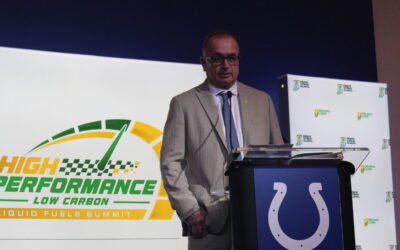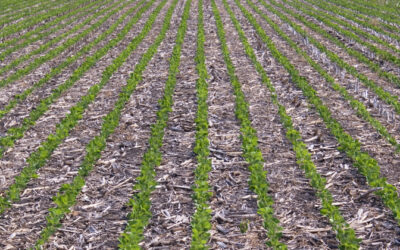U.S. Soy’s profit potential for feed in Asia touted at Bangkok meeting
By Tom D’Alfonso, USSEC Director of Animal Nutrition and Aquaculture

The global feed industry is being asked to do more with less – sustainably deliver more performance for less cost. Indiana soybean farmers are producing a solution. The U.S. Soybean Export Council (USSEC) is taking that solution, U.S. Soy, to customers in the expanding Asian market.
In mid-March, USSEC brought U.S. Soy to VIV Asia 2025, Asia’s largest feed-to-food event, focusing on livestock production and related sectors. Hosted biennially in Bangkok, Thailand, the 2025 event attracted more than 51,000 attendees from 129 countries.
As a first-time sponsor and exhibitor, USSEC participated in VIV Asia to promote U.S. soybean producers and strengthen U.S. Soy’s presence in Asia. Throughout the tradeshow, the USSEC team met with leading feed, animal and aquaculture companies, and we participated in industry media interviews. I also had the privilege of making a keynote address, as well as moderating a panel discussion featuring three other feed and sustainability experts.
In everything, our team explained how profitability and sustainability go hand-in-hand in modern feed formulations. We emphasized the economic and environmental advantages of U.S. Soy, particularly its consistent quality, superior digestibility and lowest carbon footprint compared to soy of other origins.
We made it clear: U.S. Soy isn’t just an ingredient — it’s a proven solution for better animal nutrition, stronger business performance and a more sustainable future.
Providing economic value
During our presentations, we highlighted how consistency in nutrient quality is a true predictor of economic value. Our research shows that U.S. Soy delivers a premium value of $25 to $35 per metric ton versus soy of other origins, like Brazil. Because U.S. soybean meal is more consistent and predictable in its nutrient content – especially in digestible amino acids and energy – global nutritionists can formulate animal diets with greater precision.
This reduces the need to “over-formulate” nutrients as a safeguard, ultimately saving on feed costs while still meeting animals’ nutritional requirements. Soybean meal from U.S. Soy also delivers improved performance, thanks to its reliable digestibility and nutrient bundle.
As part of our panel discussion, Chaiyapoom Bunchasak, professor of animal science for Kasetsart University in Thailand, delivered a compelling perspective on Thailand’s nutrition policy evolution.
He argued for shifting feed standards away from crude protein to more meaningful metrics like amino acid digestibility. His research reinforces USSEC’s position that crude protein is an outdated metric.
U.S. Soy’s value lies in its digestibility, nutrient consistency, and lower nitrogen excretion—supporting both animal performance and sustainability.
In my keynote, I echoed that the animal nutrition industry would benefit from moving beyond crude protein as a measure of quality and shifting toward digestible amino acids. That is where U.S. Soy excels.
Delivering sustainability
Sustainability has become a requirement for livestock feed.
During our panel, Basilisa Reas, Ph.D., USSEC technical director of soybean meal and animal protein in Southeast Asia, shared how ingredient selection impacts carbon footprint. She offered practical strategies to update nutrient databases and use sustainability metrics in feed formulation.
Lifecycle data shows that U.S. Soy has a lower carbon footprint per metric ton of feed compared to Brazilian and Argentine soy, offering buyers a clear sustainability advantage. For companies that prioritize environmental responsibility, U.S. Soy delivers both economic return and reduced emissions—making it the strategic ingredient of choice.
As part of the panel, Tarik Eluri, USSEC sustainability manager, highlighted the origins of U.S. conservation practices used in Indiana and throughout the country, the role of family farms and the carbon footprint advantages of U.S. Soy. He emphasized tools like the U.S. Soy Sustainability Assurance Protocol (SSAP) and transferable certificates that support transparent, measurable sustainability claims.
One of the most notable outcomes of the week was the Thai Feed Millers Association reinforcing their collaboration with USSEC.
The organization aims to enhance the competitiveness of the Thai feed milling industry, and it recognized U.S. Soy as a key partner in meeting their environmental and nutritional goals.
Promoting real value
VIV Asia 2025 is a recent example of the way USSEC works to emphasize the quality and sustainability of the soybeans grown in Indiana and exported around the world.
Support from the Indiana Soybean Alliance, the state’s soy checkoff program, enables us to tell current and potential customers about the quality, profitability and sustainability U.S. Soy delivers.
We know that real value is built on trust, data and performance. Thanks to Indiana soybean farmers, U.S. Soy delivers on all three.
Posted: May 24, 2025
Category: Indiana Corn and Soybean Post - May 2025, ISA, News, USSEC




